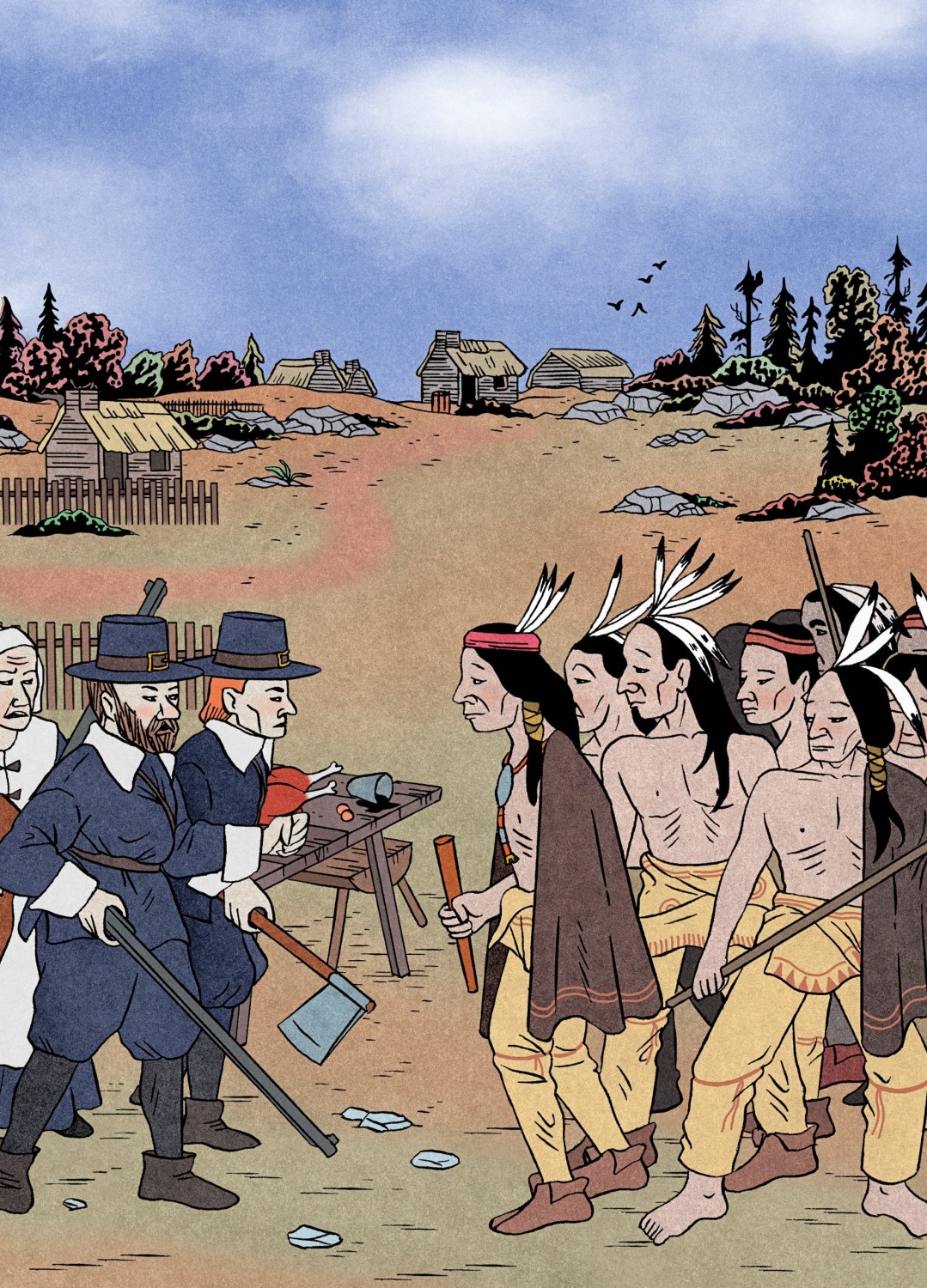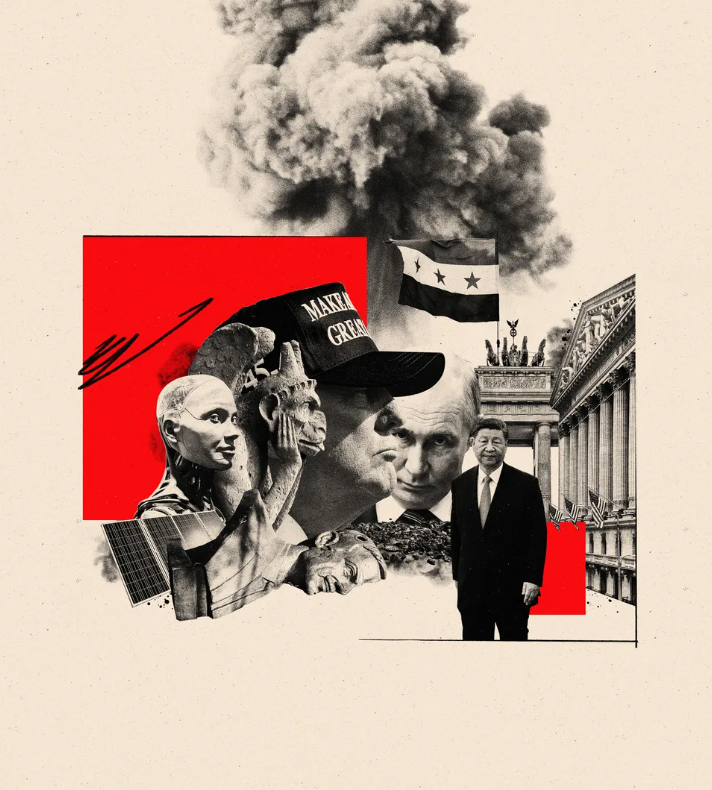
This article is more than
1 year oldThe Invention of Thanksgiving

Autumn is the season for Native America. There are the cool nights and warm days of Indian summer and the genial query “What’s Indian about this weather?” More wearisome is the annual fight over the legacy of Christopher Columbus—a bold explorer dear to Italian-American communities, but someone who brought to this continent forms of slavery that would devastate indigenous populations for centuries. Football season is in full swing, and the team in the nation’s capital revels each week in a racist performance passed off as “just good fun.” As baseball season closes, one prays that Atlanta (or even semi-evolved Cleveland) will not advance to the World Series. Next up is Halloween, typically featuring “Native American Brave” and “Sexy Indian Princess” costumes. November brings Native American Heritage Month and tracks a smooth countdown to Thanksgiving. In the elementary-school curriculum, the holiday traditionally meant a pageant, with students in construction-paper headdresses and Pilgrim hats reënacting the original celebration. If today’s teachers aim for less pageantry and a slightly more complicated history, many students still complete an American education unsure about the place of Native people in the nation’s past—or in its present. Cap the season off with Thanksgiving, a turkey dinner, and a fable of interracial harmony. Is it any wonder that by the time the holiday arrives a lot of American Indian people are thankful that autumn is nearly over?
Americans have been celebrating Thanksgiving for nearly four centuries, commemorating that solemn dinner in November, 1621. We know the story well, or think we do. Adorned in funny hats, large belt buckles, and clunky black shoes, the Pilgrims of Plymouth gave thanks to God for his blessings, demonstrated by the survival of their fragile settlement. The local Indians, supporting characters who generously pulled the Pilgrims through the first winter and taught them how to plant corn, joined the feast with gifts of venison. A good time was had by all, before things quietly took their natural course: the American colonies expanded, the Indians gave up their lands and faded from history, and the germ of collective governance found in the Mayflower Compact blossomed into American democracy.
Almost none of this is true, as David Silverman points out in “This Land Is Their Land: The Wampanoag Indians, Plymouth Colony, and the Troubled History of Thanksgiving” (Bloomsbury). The first Thanksgiving was not a “thanksgiving,” in Pilgrim terms, but a “rejoicing.” An actual giving of thanks required fasting and quiet contemplation; a rejoicing featured feasting, drinking, militia drills, target practice, and contests of strength and speed. It was a party, not a prayer, and was full of people shooting at things. The Indians were Wampanoags, led by Ousamequin (often called Massasoit, which was a leadership title rather than a name). An experienced diplomat, he was engaged in a challenging game of regional geopolitics, of which the Pilgrims were only a part. While the celebrants might well have feasted on wild turkey, the local diet also included fish, eels, shellfish, and a Wampanoag dish called nasaump, which the Pilgrims had adopted: boiled cornmeal mixed with vegetables and meats. There were no potatoes (an indigenous South American food not yet introduced into the global food system) and no pies (because there was no butter, wheat flour, or sugar).
Nor did the Pilgrims extend a warm invitation to their Indian neighbors. Rather, the Wampanoags showed up unbidden. And it was not simply four or five of them at the table, as we often imagine. Ousamequin, the Massasoit, arrived with perhaps ninety men—more than the entire population of Plymouth. Wampanoag tradition suggests that the group was in fact an army, honoring a mutual-defense pact negotiated the previous spring. They came not to enjoy a multicultural feast but to aid the Pilgrims: hearing repeated gunfire, they assumed that the settlers were under attack. After a long moment of suspicion (the Pilgrims misread almost everything that Indians did as potential aggression), the two peoples recognized one another, in some uneasy way, and spent the next three days together.
No centuries-long continuity emerged from that 1621 meet-up. New Englanders certainly celebrated Thanksgivings—often in both fall and spring—but they were of the fasting-and-prayer variety. Notable examples took place in 1637 and 1676, following bloody victories over Native people. To mark the second occasion, the Plymouth men mounted the head of Ousamequin’s son Pumetacom above their town on a pike, where it remained for two decades, while his dismembered and unburied body decomposed. The less brutal holiday that we celebrate today took shape two centuries later, as an effort to entrench an imagined American community. In 1841, the Reverend Alexander Young explicitly linked three things: the 1621 “rejoicing,” the tradition of autumnal harvest festivals, and the name Thanksgiving. He did so in a four-line throwaway gesture and a one-line footnote. Of such half thoughts is history made.
A couple of decades later, Sarah Josepha Hale, the editor of Godey’s Lady’s Book, proposed a day of unity and remembrance to counter the trauma of the Civil War, and in 1863 Abraham Lincoln declared the last Thursday of November to be that national holiday, following Young’s lead in calling it Thanksgiving. After the Civil War, Thanksgiving developed rituals, foodways, and themes of family—and national—reunion. Only later would it consolidate its narrative around a harmonious Pilgrim-Wampanoag feast, as Lisa Blee and Jean O’Brien point out in “Monumental Mobility: The Memory Work of Massasoit” (North Carolina), which tells the story of how the holiday myth spread. Fretting over late-nineteenth- and early-twentieth-century immigration, American mythmakers discovered that the Pilgrims, and New England as a whole, were perfectly cast as national founders: white, Protestant, democratic, and blessed with an American character centered on family, work, individualism, freedom, and faith.
The new story aligned neatly with the defeat of American Indian resistance in the West and the rising tide of celebratory regret that the anthropologist Renato Rosaldo once called “imperialist nostalgia.” Glorifying the endurance of white Pilgrim founders diverted attention from the brutality of Jim Crow and racial violence, and downplayed the foundational role of African slavery. The fable also allowed its audience to avert its eyes from the marginalization of Asian and Latinx labor populations, the racialization of Southern European and Eastern European immigrants, and the rise of eugenics. At Thanksgiving, white New England cheerfully shoved the problematic South and West off to the side, and claimed America for itself.
The challenge for scholars attempting to rewrite Thanksgiving is the challenge of confronting an ideology that has long since metastasized into popular history. Silverman begins his book with a plea for the possibility of a “critical history.” It will be “hard on the living,” he warns, because this approach questions the creation stories that uphold traditional social orders, making the heroes less heroic, and asking readers to consider the villains as full and complicated human beings. Nonetheless, he says, we have an obligation to try.
So how does one take on a myth? One might begin by deconstructing the process through which it was made. Silverman sketches a brief account of Hale, Lincoln, and the marketing of a fictionalized New England. Blee and O’Brien reveal how proliferating copies of a Massasoit statue, which we can recognize as not so distant kin to Confederate monuments, do similar cultural work, linking the mythic memory of the 1621 feast with the racial, ethnic, and national-identity politics of 1921, when the original statue was commissioned. One might also wield the historian’s skills to tell a “truer,” better story that exposes the myth for the self-serving fraud that it is. Silverman, in doing so, resists the temptation to offer a countermyth, an ideological narrative better suited to the contemporary moment, and renders the Wampanoags not simply as victims but as strugglers, fighting it out as they confront mischance and aggression, disagreeing with one another, making mistakes, displaying ambition and folly, failing to see their peril until it is too late.
In the story that many generations of Americans grew up hearing, there were no Wampanoags until the Pilgrims encountered them. If Thanksgiving has had no continuous existence across the centuries, however, the Wampanoag people have. Today, they make up two federally recognized tribes, the Mashpee Wampanoag Tribe and the Wampanoag Tribe of Gay Head, and they descend from a confederation of groups that stretched across large areas of Massachusetts, including Cape Cod, Martha’s Vineyard, and Nantucket.
In the years before the Pilgrims’ landing, trails and roads connected dozens of Wampanoag communities with gathering sites, hunting and fishing areas, and agricultural plots. North America’s defining indigenous agriculture—the symbiotic Three Sisters of corn, beans, and squash—came late to the region, adopted perhaps two hundred years before Europeans appeared. That’s when the Wampanoags, who moved seasonally between coastal summer residences (not unlike Cape Cod today) and protected winter homes inland, took up farming. Cultivation and cropping created a need for shared-use land management and an indigenous notion of property. That led in turn to the consolidation of a system of sachems, leaders who navigated the internal needs of their communities, established tributary and protectorate relationships with nearby communities, and negotiated diplomatic relations with outsiders. When the Pilgrims encountered Ousamequin, they were meeting a paramount sachem, a Massasoit, who commanded the respect necessary to establish strategy for other groups in the region.
The Pilgrims were not the only Europeans the Wampanoags had come across. The first documented contact occurred in 1524, and marked the start of a century of violent encounters, captivity, and enslavement. By 1620, the Wampanoags had had enough, and were inclined to chase off any ship that sought to land. They sent a French colonizing mission packing and had driven the Pilgrims away from a previous landing site, on the Cape. Ousamequin’s people debated for months about whether to ally with the newcomers or destroy them. When they decided to begin diplomacy, they were guided by Tisquantum (you may recall him as Squanto) and Epenow, New England natives who had been captured, held in bondage in Britain, and trained as interpreters by the English before eventually finding their way back across the Atlantic.
Why would Ousamequin decide to welcome the newcomers and, in 1621, make a mutual-defense pact with them? During the preceding years, an epidemic had struck Massachusetts Bay Indians, killing between seventy-five and ninety per cent of the Wampanoag and the Massachusett people. A rich landscape of fields and gardens, tended hunting forests, and fishing weirs was largely emptied of people. Belief systems crashed. Even survival did not mean good health, and, with fields unplanted and animals uncaught, starvation followed closely behind. The Pilgrims’ settlement took place in a graveyard.
Wampanoag people consolidated their survivors and their lands, and reëstablished internal self-governance. But, to the west, the Narragansetts—traditional rivals largely untouched by the epidemic—now outnumbered the Wampanoags, and that led to the strengthening of Ousamequin’s alliances with the surviving Massachusett and another nearby group, the Nipmucks. As the paramount sachem, he also had to contend with challenges to his leadership from a number of other Wampanoag sachems. And so, after much debate, he decided to tolerate the rather pathetic Pilgrims—who had seen half their number die in their first winter—and establish an alliance with them. That history, understood through Wampanoag characters and motives, explains the “rejoicing” that Americans later remembered as a pumpkin-spiced tale of Thanksgiving conciliation.
This rejoicing arrives about a third of the way through Silverman’s four-hundred-plus-page book. What follows is a vivid account of the ways the English repaid their new allies. The settlers pressed hard to acquire Indian land through “sales” driven by debt, threat, alliance politics, and violence. They denied the coequal civil and criminal jurisdiction of the alliance, charging Indians under English law and sentencing them to unpayable fines, imprisonment, even executions. They played a constant game of divide and conquer, and they invariably considered Indians their inferiors. Ousamequin’s sons Pumetacom—called King Philip by the English—and Wamsutta began forming a resistance, despite the poor odds. By 1670, the immigrant population had ballooned to sixty or seventy thousand in southern New England—twice the number of Native people.
We falsely remember a Thanksgiving of intercultural harmony. Perhaps we should recall instead how English settlers cheated, abused, killed, and eventually drove Wampanoags into a conflict, known as King Philip’s War, that exploded across the region in 1675 and 1676 and that was one of the most devastating wars in the history of North American settlement. Native soldiers attacked fifty-two towns in New England, destroyed seventeen of them, and killed a substantial portion of the settler population. The region also lost as much as forty per cent of its Native population, who fought on both sides. Confronted by Mohawks to the west, a mixed set of Indian and Colonial foes to the south, and the English to the east, Pumetacom was surrounded on three sides. In the north, the scholar Lisa Brooks argues, Abenaki and other allies continued the struggle for years. In “Our Beloved Kin: A New History of King Philip’s War” (Yale), Brooks deepens the story considerably, focussing on indigenous geographical and linguistic knowledge, and tracing the life of Weetamoo, the widow of Wamsutta and the saunkskwa, or female leader, of her tribe, the Pocasset. Weetamoo was Pumetacom’s ally, his relative, and a major figure in the fight. In the end, not only Pumetacom’s head was stuck on a pike; hers was, too, displayed for Wampanoag prisoners who were likely soon to be sold to the Caribbean.
The Thanksgiving story buries the major cause of King Philip’s War—the relentless seizure of Indian land. It also covers up the consequence. The war split Wampanoags, as well as every other Native group, and ended with indigenous resistance broken, and the colonists giving thanks. Like most Colonial wars, this one was a giant slave expedition, marked by the seizure and sale of Indian people. Wampanoags were judged criminals and—in a foreshadowing of the convict-labor provision of the Thirteenth Amendment—sold into bondage. During the next two centuries, New England Indians also suffered indentured servitude, convict labor, and debt peonage, which often resulted in the enslavement of the debtor’s children. Thanksgiving’s Pilgrim pageants suggest that good-hearted settlers arrived from pious, civilized England. We could remember it differently: that they came from a land that delighted in displaying heads on poles and letting bodies rot in cages suspended above the roads. They were a warrior tribe.
Despite continued demographic decline, loss of land, and severe challenges to shared social identities, Wampanoags held on. With so many men dead or enslaved, Native women married men outside their group—often African-Americans—and then redefined the families of mixed marriages as matrilineal in order to preserve collective claims to land. They adopted the forms of the Christian church, to some degree, in order to gain some breathing space. They took advantage of the remoteness of their settlements to maintain self-governance. And by the late twentieth century they began revitalizing what had been a “sleeping” language, and gained federal recognition as a tribal nation. Today, Wampanoag people debate whether Thanksgiving should be a day of mourning or a chance to contemplate reconciliation. It’s mighty generous of them.
David Silverman, in his personal reflections, considers how two secular patriotic hymns, “This Land Is Your Land” and “My Country ’Tis of Thee,” shaped American childhood experiences. When schoolkids sing “Land where my fathers died! Land of the Pilgrim’s pride,” he suggests, they name white, Protestant New England founders. It makes no sense, these days, to ask ethnically diverse students to celebrate those mythic dudes, with their odd hats and big buckles. At the very least, Silverman asks, could we include Indians among “my fathers,” and pay better attention to the ways they died? Could we acknowledge that Indians are not ghosts in the landscape or foils in a delusional nationalist dream, but actual living people?
This sentiment bumps a little roughly against a second plea: to recognize the falsely inclusive rhetoric in the phrase “This land is your land, this land is my land.” Those lines require the erasure of Indian people, who don’t get to be either “you” or “me.” American Indian people are at least partly excluded from the United States political system, written into the Constitution (in the three-fifths clause and the Fourteenth Amendment, for example, where they appear as “Indians not taxed”) so as to exist outside it. Native American tribes are distinct political entities, sovereign nations in their own right.
“American Indian” is a political identity, not a racial one, constituted by formal, still living treaties with the United States government and a long series of legal decisions. Today, the Trump Administration would like to deny this history, wrongly categorize Indians as a racial group, and disavow ongoing treaty relationships. Native American tribal governments are actively resisting this latest effort to dismember the past, demanding better and truer Indian histories and an accounting of the obligations that issue from them. At the forefront of that effort you’ll find the Mashpee Wampanoags, those resilient folks whose ancestors came, uninvited, to the first “Thanksgiving” almost four centuries ago in order to honor the obligations established in a mutual-defense agreement—a treaty—they had made with the Pilgrims of Plymouth Colony.




